steering wheel TOYOTA SEQUOIA 2020 Warranties & Maintenance Guides (in English)
[x] Cancel search | Manufacturer: TOYOTA, Model Year: 2020, Model line: SEQUOIA, Model: TOYOTA SEQUOIA 2020Pages: 260, PDF Size: 8.54 MB
Page 11 of 260
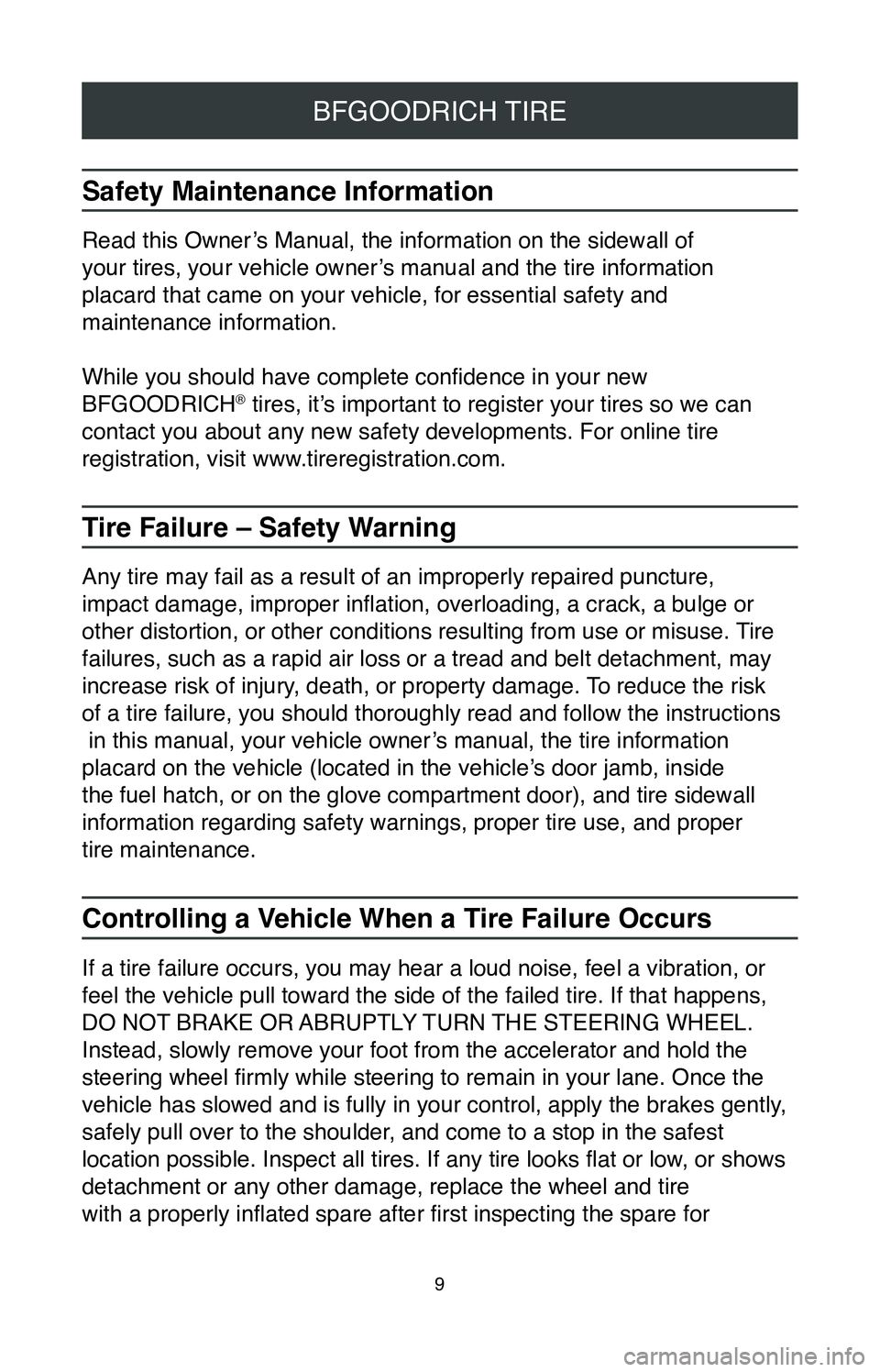
9
BFGOODRICH TIRE
Safety Maintenance Information
Read this Owner’s Manual, the information on the sidewall of
your tires, your vehicle owner’s manual and the tire information
placard that came on your vehicle, for essential safety and
maintenance information.
While you should have complete confidence in your new
BFGOODRICH
® tires, it’s important to register your tires so we can
contact you about any new safety developments. For online tire
registration, visit www.tireregistration.com.
Tire Failure – Safety Warning
Any tire may fail as a result of an improperly repaired puncture,
impact damage, improper inflation, overloading, a crack, a bulge or
other distortion, or other conditions resulting from use or misuse. Tire
failures, such as a rapid air loss or a tread and belt detachment, may
increase risk of injury, death, or property damage. To reduce the risk
of a tire failure, you should thoroughly read and follow the instruction\
s
in this manual, your vehicle owner’s manual, the tire information
placard on the vehicle (located in the vehicle’s door jamb, inside
the fuel hatch, or on the glove compartment door), and tire sidewall
information regarding safety warnings, proper tire use, and proper
tire maintenance.
Controlling a Vehicle When a Tire Failure Occurs
If a tire failure occurs, you may hear a loud noise, feel a vibration, o\
r
feel the vehicle pull toward the side of the failed tire. If that happen\
s,
DO NOT BRAKE OR ABRUPTLY TURN THE STEERING WHEEL.
Instead, slowly remove your foot from the accelerator and hold the
steering wheel firmly while steering to remain in your lane. Once the
vehicle has slowed and is fully in your control, apply the brakes gently\
,
safely pull over to the shoulder, and come to a stop in the safest
location possible. Inspect all tires. If any tire looks flat or low , or shows
detachment or any other damage, replace the wheel and tire
with a properly inflated spare after first inspecting the spare for
Page 26 of 260
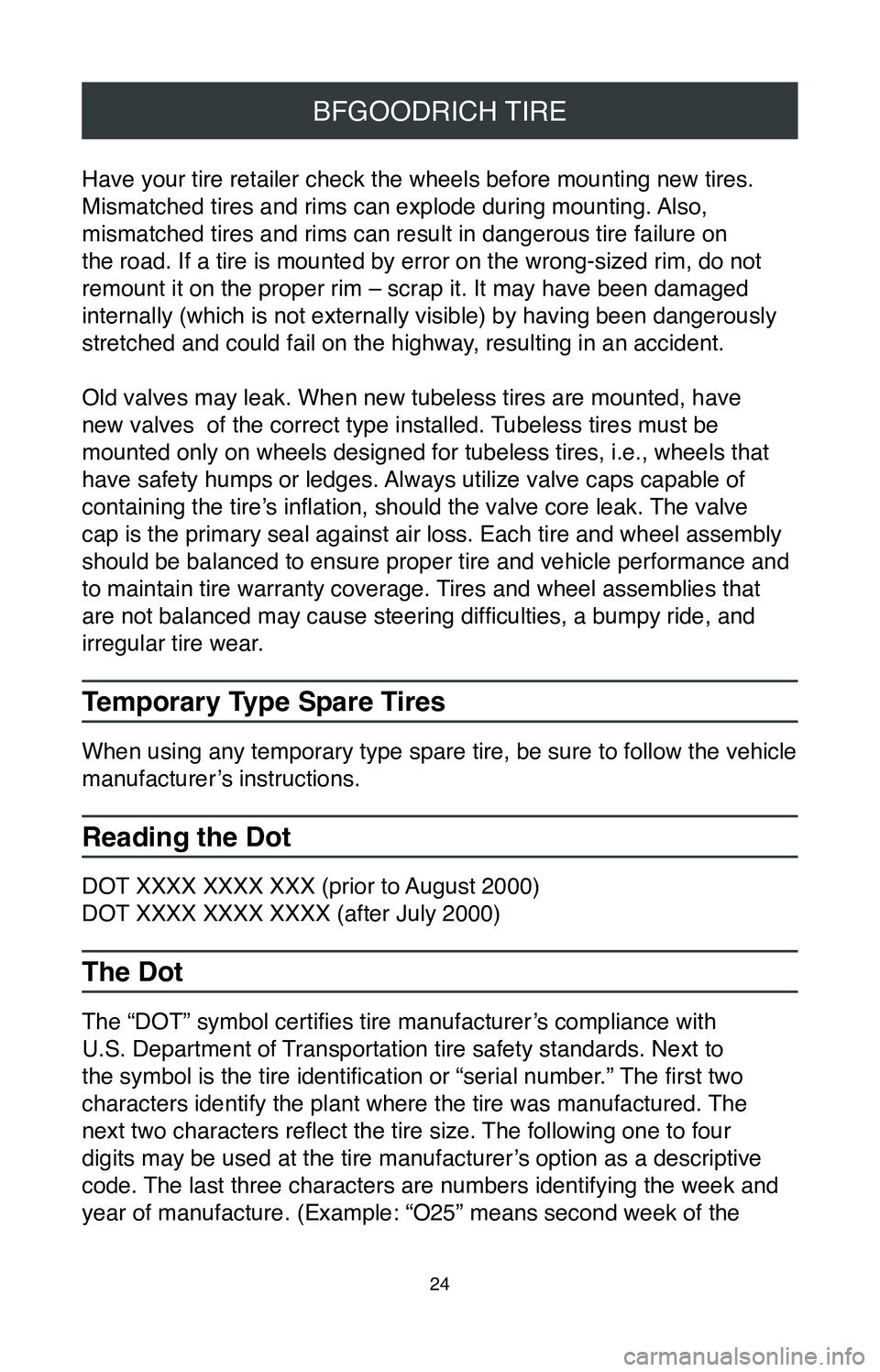
24
BFGOODRICH TIRE
Have your tire retailer check the wheels before mounting new tires.
Mismatched tires and rims can explode during mounting. Also,
mismatched tires and rims can result in dangerous tire failure on
the road. If a tire is mounted by error on the wrong-sized rim, do not
remount it on the proper rim – scrap it. It may have been damaged
internally (which is not externally visible) by having been dangerously
stretched and could fail on the highway, resulting in an accident.
Old valves may leak. When new tubeless tires are mounted, have
new valves of the correct type installed. Tubeless tires must be
mounted only on wheels designed for tubeless tires, i.e., wheels that
have safety humps or ledges. Always utilize valve caps capable of
containing the tire’s inflation, should the valve core leak. The valve
cap is the primary seal against air loss. Each tire and wheel assembly
should be balanced to ensure proper tire and vehicle performance and
to maintain tire warranty coverage. Tires and wheel assemblies that
are not balanced may cause steering difficulties, a bumpy ride, and
irregular tire wear.
Temporary Type Spare Tires
When using any temporary type spare tire, be sure to follow the vehicle \
manufacturer’s instructions.
Reading the Dot
DOT XXXX XXXX XXX (prior to August 2000)
DOT XXXX XXXX XXXX (after July 2000)
The Dot
The “DOT” symbol certifies tire manufacturer’s compliance with
U.S. Department of Transportation tire safety standards. Next to
the symbol is the tire identification or “serial number.” The first two
characters identify the plant where the tire was manufactured. The
next two characters reflect the tire size. The following one to four
digits may be used at the tire manufacturer’s option as a descriptive
code. The last three characters are numbers identifying the week and
year of manufacture. (Example: “O25” means second week of the
Page 35 of 260

BRIDGESTONE / FIRESTONE
33
Tire Maintenance and Safety Information
Any tire, no matter how well constructed, may fail in use as a result of\
punctures, impact damage, improper inflation, overloading, or other
conditions resulting from use or misuse. Tire failure may create a risk
of property damage, serious personal injury or death.SAFETY WARNING
Serious personal injury or death may result from a tire failure. Many tire
failures are preceded by vibration, bumps, bulges or irregular wear. If a
vibration occurs while driving your vehicle or you notice a bump, bulge \
or irregular wear, have your tires and vehicle evaluated by a qualified
tire service professional.
To reduce the risk of tire failure, Bridgestone Americas Tire
Operations, LLC strongly recommends you read and follow
all safety information contained in this manual. In addition, we
recommend periodic inspection and maintenance, if necessary,
by a qualified tire service professional.
Tire Failure While Driving
SAFETY WARNING
It is not often that a properly maintained tire will “blow out” wh\
ile you
are driving. More commonly, if inflation pressure is lost, it will be
gradual. If you do experience a blowout or sudden tire
failure, the
following information should be helpful:
• When the failure occurs, you may hear a loud noise, feel a
vibration, and/or the vehicle may pull toward the side of the
failed tire.
•
DO NOT abruptly brake or turn.
•
Slowly remove your foot from the accelerator, hold the steering
wheel firmly, and steer to maintain your lane position.
•
Once the vehicle has slowed, apply the brakes gently.
•
Gradually pull over to the shoulder and come to a stop, as far off
the road as possible.
Page 125 of 260

MICHELIN
123
Safety Maintenance Information
Read this Owner’s Manual, the information on the sidewall of your
tires, your vehicle owner’s manual and the tire information placard
that came on your vehicle, for essential safety and maintenance
information.
While you should have complete confidence in your new MICHELIN
®
tires, it’s important to register your tires so we can contact you
about any new safety developments. For online tire registration, visit
tireregistration.com.
Tire Failure – Safety Warning
Any tire may fail as a result of an improperly repaired puncture,
impact damage, improper inflation, overloading, a crack, a bulge or
other distortion, or other conditions resulting from use or misuse. Tire
failures, such as a rapid air loss or a tread and belt detachment, may
increase risk of injury, death, or property damage. To reduce the risk
ofa tire failure, you should thoroughly read and follow the instructions\
in this manual, your vehicle owner’s manual, the tire information
placard on the vehicle (located in the vehicle’s door jamb, inside
the fuel hatch, or on the glove compartment door), and tire sidewall
information regarding safety warnings, proper tire use, and proper
tire maintenance.
Controlling a Vehicle When a Tire Failure Occurs
If a tire failure occurs, you may hear a loud noise, feel a vibration, o\
r
feel the vehicle pull toward the side of the failed tire. If that happen\
s,
DO NOT BRAKE OR ABRUPTLY TURN THE STEERING WHEEL.
Instead, slowly remove your foot from the accelerator and hold the
steering wheel firmly while steering to remain in your lane. Once
the vehicle has slowed and is fully in your control, apply the brakes
gently, safely pull over to the shoulder, and come to a stop in the
safest location possible. Inspect all tires. If any tire looks flat or low ,
or shows detachment or any other damage, replace the wheel and
tire with a properly inflated spare after first inspecting the spare for
Page 143 of 260
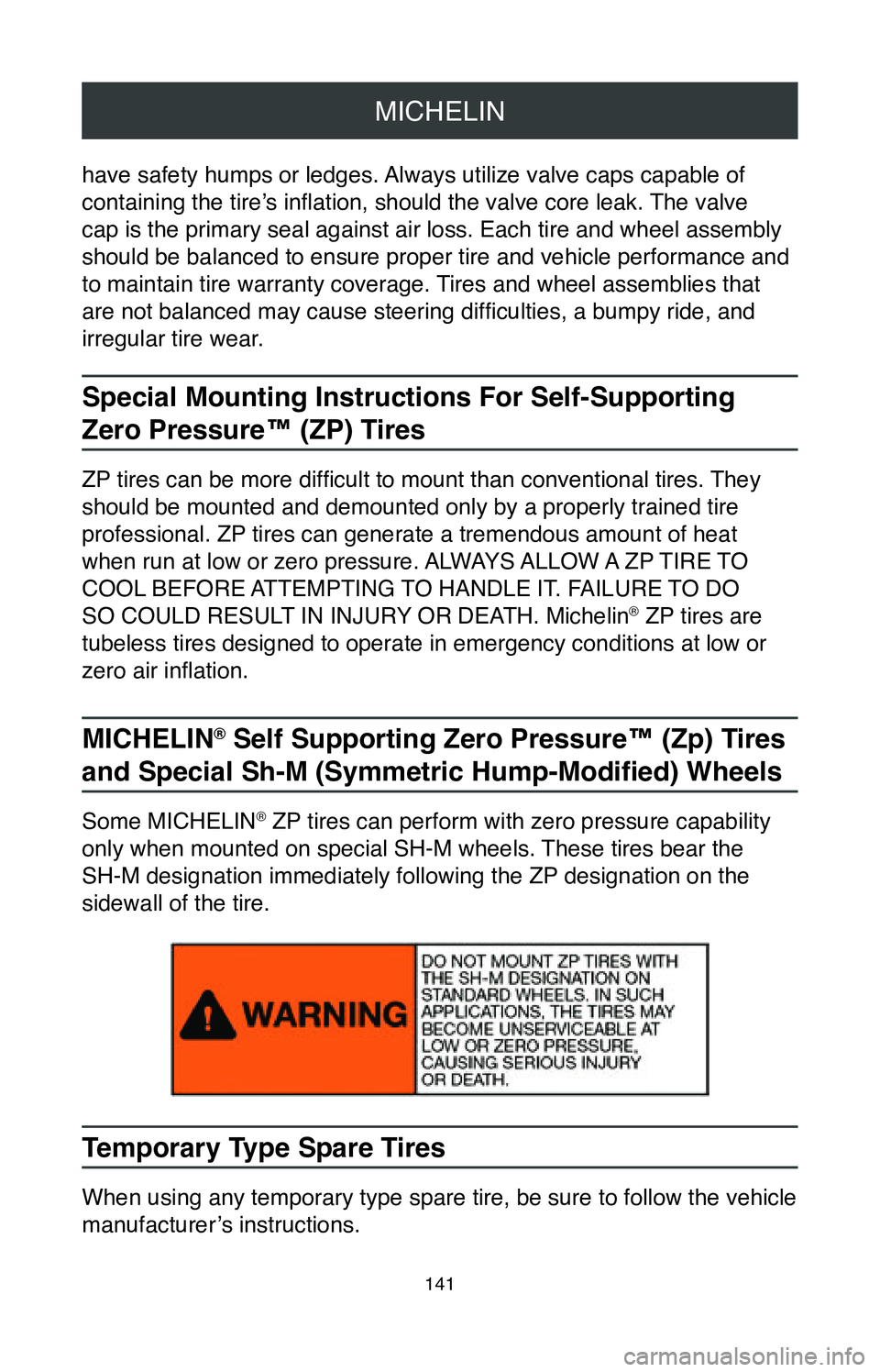
MICHELIN
141
have safety humps or ledges. Always utilize valve caps capable of
containing the tire’s inflation, should the valve core leak. The valve
cap is the primary seal against air loss. Each tire and wheel assembly
should be balanced to ensure proper tire and vehicle performance and
to maintain tire warranty coverage. Tires and wheel assemblies that
are not balanced may cause steering difficulties, a bumpy ride, and
irregular tire wear.
Special Mounting Instructions For Self-Supporting
Zero Pressure™ (ZP) Tires
ZP tires can be more difficult to mount than conventional tires. They
should be mounted and demounted only by a properly trained tire
professional. ZP tires can generate a tremendous amount of heat
when run at low or zero pressure. ALWAYS ALLOW A ZP TIRE TO
COOL BEFORE ATTEMPTING TO HANDLE IT. FAILURE TO DO
SO COULD RESULT IN INJURY OR DEATH. Michelin
® ZP tires are
tubeless tires designed to operate in emergency conditions at low or
zero air inflation.
MICHELIN® Self Supporting Zero Pressure™ (Zp) Tires
and Special Sh-M (Symmetric Hump-Modified) Wheels
Some MICHELIN® ZP tires can perform with zero pressure capability
only when mounted on special SH-M wheels. These tires bear the
SH-M designation immediately following the ZP designation on the
sidewall of the tire.
Temporary Type Spare Tires
When using any temporary type spare tire, be sure to follow the vehicle \
manufacturer’s instructions.
Page 171 of 260
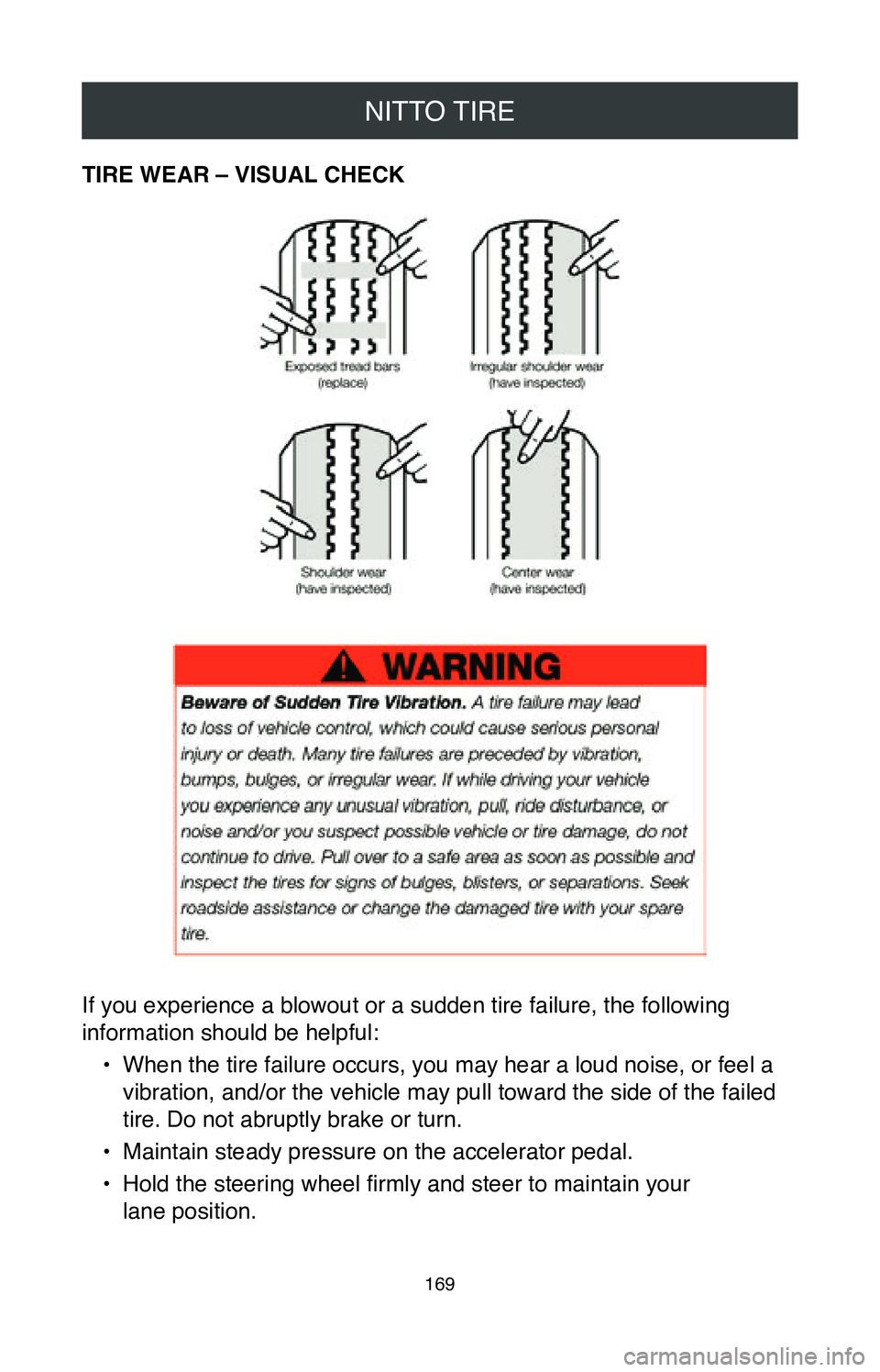
NITTO TIRE
169
TIRE WEAR – VISUAL CHECK
If you experience a blowout or a sudden tire failure, the following
information should be helpful:•
When the tire failure occurs, you may hear a loud noise, or feel a
vibration, and/or the vehicle may pull toward the side of the failed
tire. Do not abruptly brake or turn.
•
Maintain steady pressure on the accelerator pedal.
•
Hold the steering wheel firmly and steer to maintain your
lane position.
Page 231 of 260
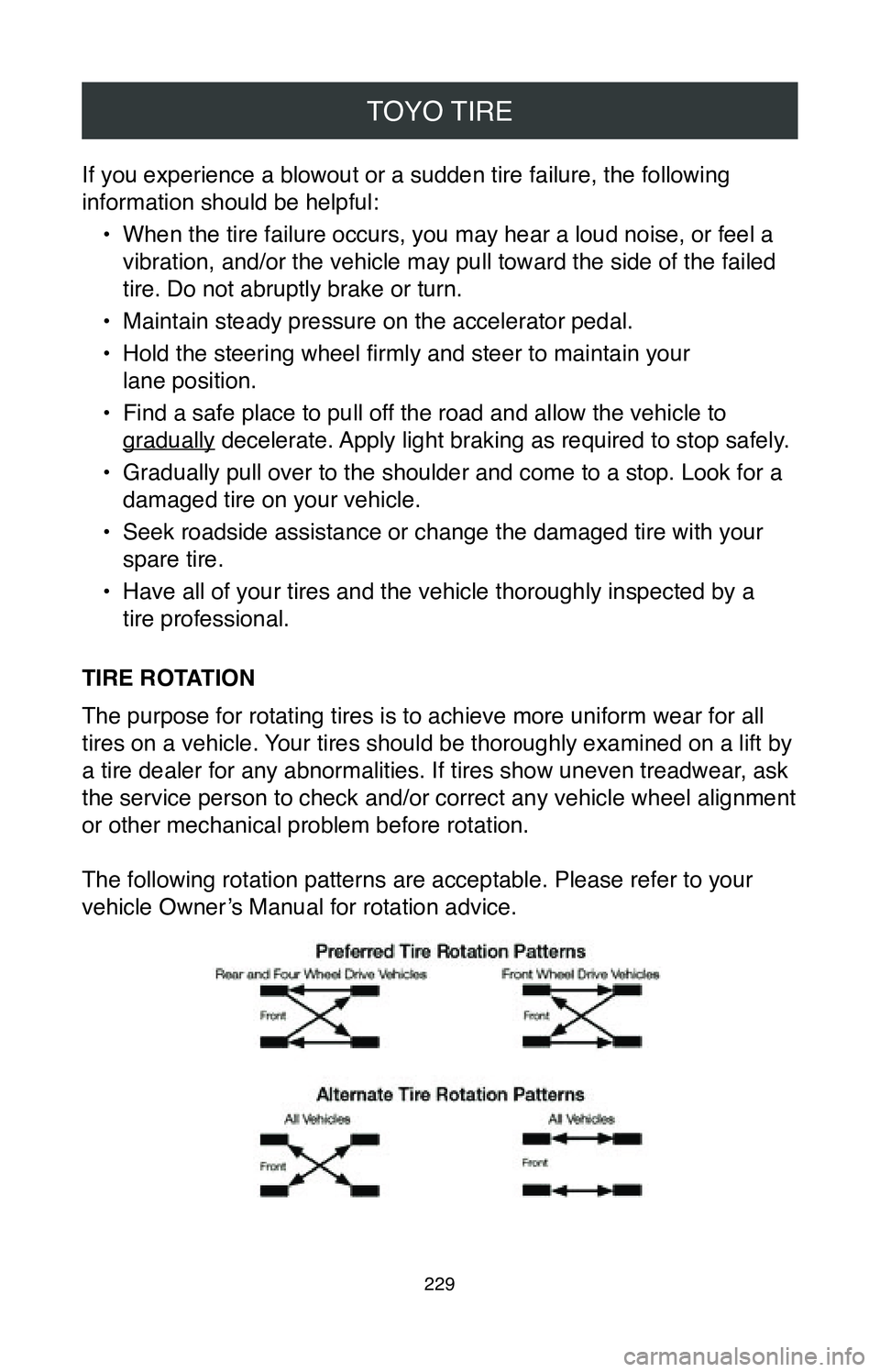
TOYO TIRE
229
If you experience a blowout or a sudden tire failure, the following
information should be helpful:•
When the tire failure occurs, you may hear a loud noise, or feel a
vibration, and/or the vehicle may pull toward the side of the failed
tire. Do not abruptly brake or turn.
•
Maintain steady pressure on the accelerator pedal.
•
Hold the steering wheel firmly and steer to maintain your
lane position.
•
Find a safe place to pull off the road and allow the vehicle to
gradually decelerate. Apply light braking as required to stop safely.
•
Gradually pull over to the shoulder and come to a stop. Look for a
damaged tire on your vehicle.
•
Seek roadside assistance or change the damaged tire with your
spare tire.
•
Have all of your tires and the vehicle thoroughly inspected by a
tire professional.
TIRE ROTATION
The purpose for rotating tires is to achieve more uniform wear for all
tires on a vehicle. Your tires should be thoroughly examined on a lift by
a tire dealer for any abnormalities. If tires show uneven treadwear, ask
the service person to check and/or correct any vehicle wheel alignment
or other mechanical problem before rotation.
The following rotation patterns are acceptable. Please refer to your
vehicle Owner’s Manual for rotation advice.